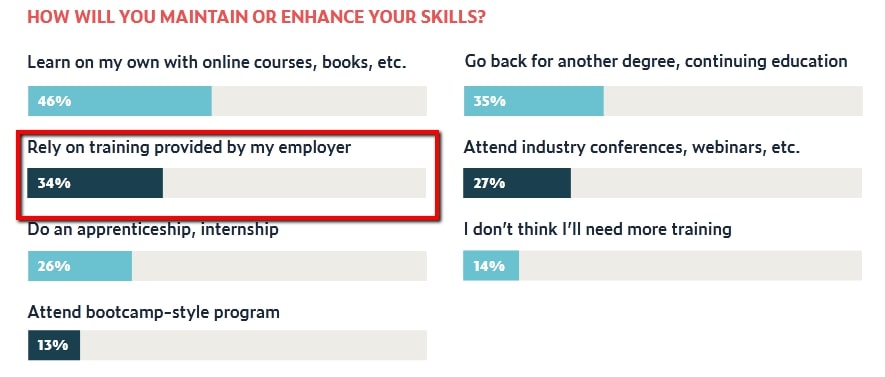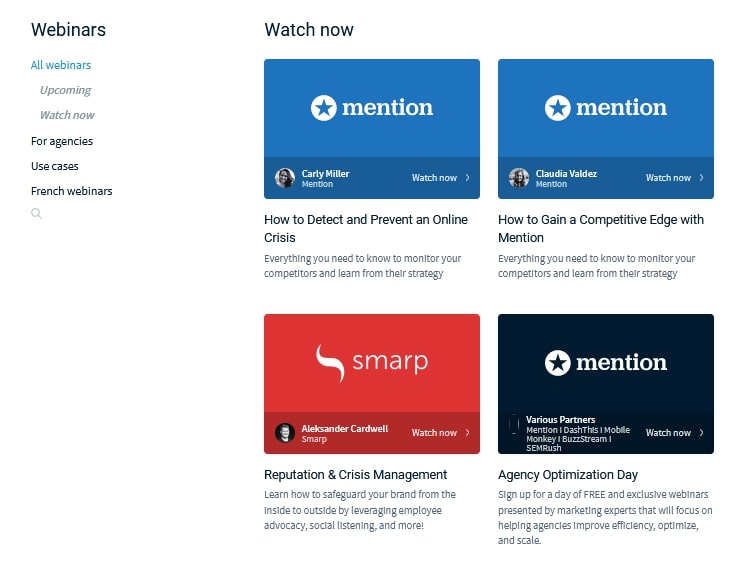When you scale your company, you need new leaders. Even if you have no expansion plans, it’s always a good idea to upskill your employees.
Instead of hiring new employees and investing more money into recruitment and training, you can groom your existing workforce for leadership positions.
But why?
The cost benefit is a big plus, in my opinion. Upskilling employees has many other pros as well. It results in better productivity, higher retention rates, and improved employee morale. Employees like to work for companies that offer them opportunities to grow professionally and improve their skill set.
Udemy’s “Millennials at Work Report” states that 34% of workers rely on their employers to train them and enhance their skill sets.

Despite all of these obvious benefits, growing companies don’t always consider employee upskilling as a priority. Often, the mindset is along these lines: “…why invest in training? Let’s just get someone with experience.”
Does that sound familiar?
I bet it does. However, hiring experienced professionals doesn’t come cheap.
Wharton research proved that external hires turn out to be more costly than internally promoted employees. They also have higher exit rates and poorer performance, at least for the first two years of appointment.
That’s because in-house employees are familiar with the company’s culture and basic processes. They also share a rapport with other employees. In short, you don’t need to spend any time onboarding them for their new roles.
For all of these reasons, it makes sense to invest time and energy into upskilling your staff.
But that’s easier said than done for a busy entrepreneur/manager. In a competitive marketplace where every second counts, the last thing you want is another time-consuming activity. Conducting bootcamps for your workers may not figure on your to-do list.
What if I told you that employee training doesn’t have to take up your productive hours? In fact, a one-time effort to plan your employee training is all that’s needed. And some productivity tools of course.
Don’t believe me?
Read on to learn five great ways to upskill your teams when you are short on time.
How can you upskill your workers under time constraints?
Your staff needs training from time to time. Your training plan will depend on a number of factors, including your business needs and budget. You should also consider the training needs of individual workers so that the training that you impart satisfies their personal aspirations and professional goals.
Keeping all of these points in mind, I’ve put together some effective training tips for you. Take a look.
Table of Contents:
- Leverage in-house experts
- Use webinars and video conferences
- Build a culture of mentoring
- Take advantage of online training content
- Use personalized training tools
1. Leverage in-house experts
Your company has a resource pool of talented people. It’s quite likely that you will be able to find good trainers in-house. Since they are working for you, they will be more amenable to take on the added responsibility of training.
Most employees would be more than happy to don the trainer’s hat. For 42% of employees, a company that provides them L&D (learning & development) opportunities is a great place to work, according to the Udemy report cited earlier.

You can sweeten the deal by offering the trainers a salary increase or a better position. Don’t forget that they are helping you avoid the hassle and expenditure of recruiting new workers.
Make a list of the skills that you’re hoping to enhance with training. Then, compare them with the skill sets of your employees. Pick employees who have the required skills as well as a demonstrated history of good performance. You don’t want them to compromise on their primary duties for the sake of training.
Encourage the trainers to create a dedicated space and schedule for training. They should build a training plan, with clearly-defined goals and objectives. To keep everyone on the same page, set a reporting protocol.
At the same time, don’t stifle trainers with rigid guidelines. Since they understand the professional graphs of their colleagues, allow them to adapt their training accordingly.
2. Use webinars and video conferences
For training and skill-building, virtual tools like webinars and video conferences can be very helpful. When you feel rushed or need to connect with scattered teams, these digital tools can really help.
For time-strapped trainers, I can say that webinars offer multiple benefits, including:
- Auto-recordings of meetings for future reference
- Start-to-finish meeting planning in advance
- Option to pre-load meeting content
- Auto-schedule and duplicate recurring meetings
- Collaborative features, such as polls, screen sharing, and Q&A sessions
If you don’t have time to attend live webinars for routine catch-ups, you should use webinar platforms that can simulate live meetings. Your IT team can load your pre-recorded content blocks into a webinar framework and add the frills. Your audience won’t know the difference.
Is that all?
Not even close. To conduct webinars, you will create many proprietary documents, presentations, and videos. These content pieces can prove to be a great asset for your company. All of the content that you include will be fresh, accurate, and tailor-made for your employees.
To stretch your content’s shelf life, you can repurpose it into different formats. You can create training manuals and quick reference guides for new hires.
Take a cue from Mention. They regularly conduct webinars to train their subscribers on how to use Mention’s features optimally. Their insightful webinar content assists their sales teams in onboarding new clients.

Online flower retailer 1-800-FLOWERS takes training a step further. They teamed up with Udemy to build an online academy for training their retail florists. The Floriology Institute offers courses on floral design, human resources, and sales.

You can even generate a new income stream for your company in this way.
3. Build a culture of mentoring
New employees can find it overwhelming to adapt to their new work, company, and colleagues. Senior workers can act as mentors and give on-the-job training to their subordinates.
By delegating the task of training to your colleagues, you can reduce your workload. It also helps your teams bond and understand each others’ challenges. They can informally discuss any issues they are facing with their mentors, without involving the upper management.
Working closely with junior colleagues, mentors can identify unique traits and strengths of their subordinates. By providing them real-life situations to apply their learnings, mentors can groom them for leadership roles.
The clincher?
Mentorship has a lasting impact on employee morale. CNBC’s Workplace Happiness Survey found that 91% of workers who have a mentor to watch their back are satisfied with their jobs. They are generally more comfortable in their work environment.
4. Take advantage of online training content
You don’t need to be physically present for training and upskilling your teams. In fact, you don’t even need to be in the same time zone.
Think I’m joking?
I’m not. ELearning or digital learning has made it possible to deliver complex courses from a distance, without hampering learning outcomes in any way. The best part about these courses is that they are self-paced and affordable.
Whether it’s employee onboarding or process tutorials, there are online training courses for almost everything. If you are having second thoughts about adopting this training methodology, these eLearning stats will clear your doubts:
- Since learners can access the information they need on-demand, their learning cycles get shorter. On average, online courses deliver the same learning outcome as in-person training in 25-60% less time.
- 58% of employees prefer to learn at their own pace.

Not only that, online courses are quite cost-effective. Compared to trainer salaries and maintenance costs of training infrastructure and materials, online course fee is negligible.
Now, that’s a strong case for online courses.
So, where can you find good online courseware? There is a lot of ready-to-use eLearning courseware available in the marketplace. You just have to know the right places to look for it.
LinkedIn Learning Academy, Skillsoft, and Udemy have huge repositories of pre-built courses on a range of topics.
If you don’t find the courses you are looking for, you can build custom online courses for your specific needs. Most course builders come with drag-and-drop editors that are self-explanatory.

In a few hours, you can design bespoke courses, interspersed with activities and assessments. Bear in mind that you can reuse these courses indefinitely, without spending additional time and money.
Anything else?
You can also sponsor your workers to get certified from places like Coursera. This can be a great option if you don’t have the resources to buy or develop online courses.
Yahoo takes upskilling and training of employees very seriously. They recently got their delivery agents certified by Coursera in their Signature Track course.

Instead of training employees themselves, Yahoo decided to give this task to a trusted brand that specializes in online course delivery.
5. Use personalized training tools
To get the best results from your training modules, personalize them. From content to delivery mode, everything about your learning systems should be customizable since each learner has unique needs.
Does that sound cumbersome?
In reality, it’s not. There are many AI-powered tools like Docebo that deliver adaptive courses. The course curriculum updates according to each learner’s level and aptitude.
The software builds personal development plans (PDP) for each employee. They track each person’s progress and performance and present their findings in an easy-to-understand visual form. You get a helicopter view of where your workers stand, individually and as a team.
If you’re serious about bridging the skill gaps in your teams, invest in a mobile learning application. Your IT team can either build the app or outsource it to developers.
Using the app, your workers will be able to study on-the-go, even in their off hours. Plus, you don’t have to worry about the privacy and security of your employee’s personal data and your proprietary content.
It’s no wonder that the mobile learning market is projected to reach $38 billion this year.

So, if you want a piece of this pie, you can monetize your app by including in-app purchases or by opening it to the public for a subscription fee. In this way, you can recover your investment.
Are you ready to upskill your teams?
Upskilling your teams is a priority for smart entrepreneurs and managers. It not only helps bridge skill gaps in organizations but also reduces employee attrition. The tips mentioned in this article can help you accelerate your training programs, without much personal involvement.






